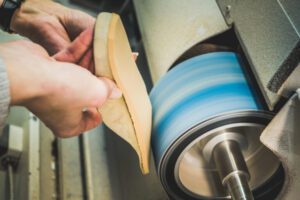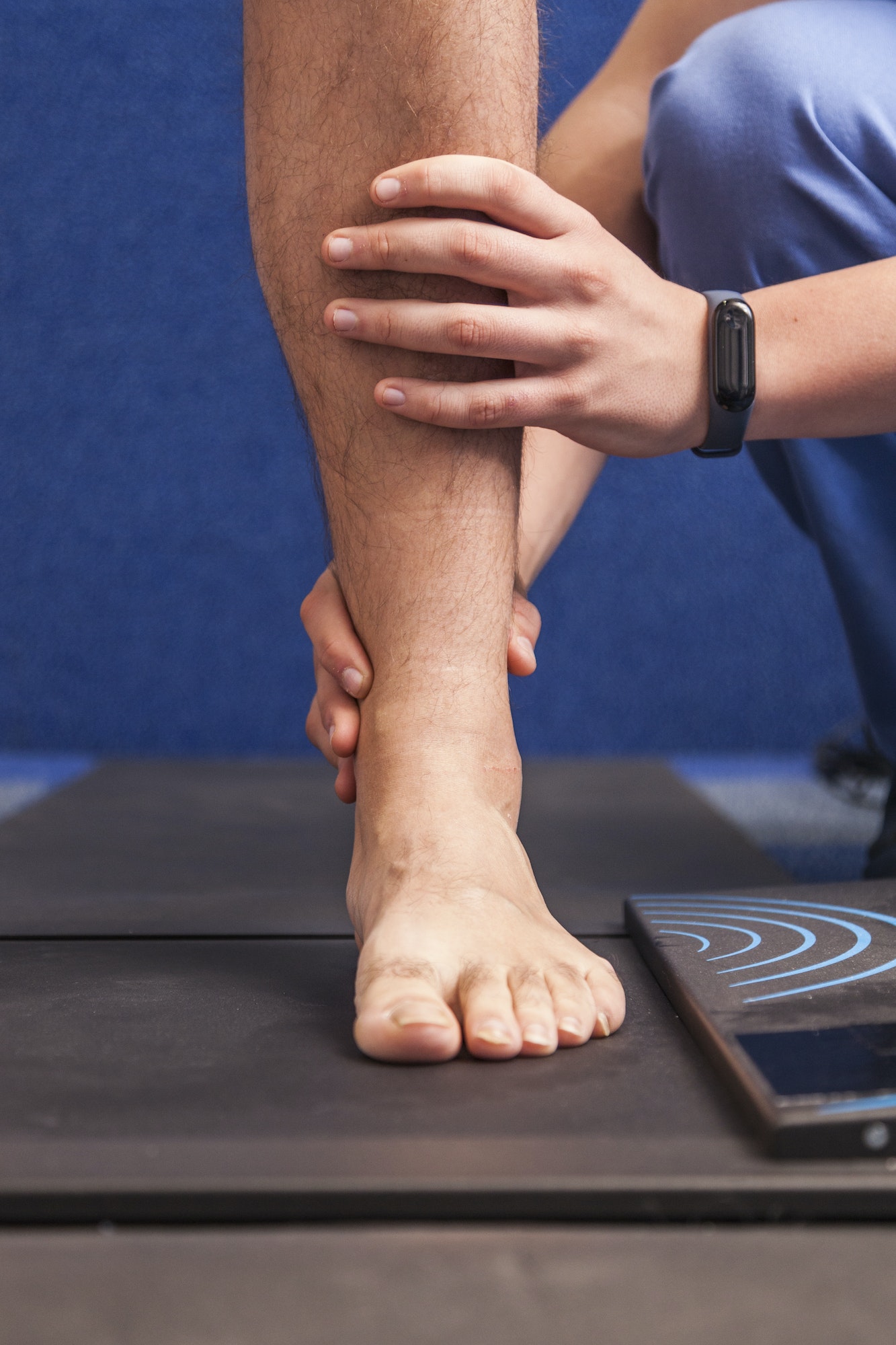Table of Contents
When you come in for pain in your feet, custom foot orthotics are very often a recommended component of your treatment plan. So, what exactly is a custom orthotic? A custom orthotic is a specialized insert that is designed to fit into your shoe. Custom orthotics can be made from a variety of different materials including plastics of various density, cork, or even carbon fiber. Very often, a ‘topcover’ is also a component of a custom orthotic and this helps to provide cushioning that assists your feet in absorbing shock from daily activities as well as athletic activities such as running. The orthotic itself is built off of an impression taken of your foot and this is part of what makes it a custom device. The impression of your feet can be taken with use of fiberglass or plaster cast material, a digital scan and in some cases a box with special foam material.
What Is The Purpose or Benefit Of A Custom Orthotic?

Unlike over the counter inserts for your shoes, functional custom orthotics are designed based off of a cast impression of your foot. Trained staff at our office typically utilize fiberglass slipper casts. After a protective bag is placed over the foot, the slipper cast is applied and while you relax, your foot is held in a position we call Subtalar joint neutral. This position refers to a joint in the back of the foot and when it is in ‘neutral’ it means that the foot is optimally positioned. The subtalar joint in a neutral position often corrects other areas of foot abnormalities which means that when the cast is complete and dried and removed from your foot, it represents your foot in its own optimal functioning position. The foot compensates from one joint to the next for any imbalances or abnormal joint positions, so casting this way is essential for a functional, corrective device. If you have had your feet scanned on a plate in a relaxed foot position, walk across a mat or stand in a foam box, these methods will provide an image of your foot, but in a position that is representing compensation your foot is already doing – likely that compensation which lead to your foot complaint when it comes to musculoskeletal conditions like tendinitis and arthritis
Types of Custom Orthotics
Another type of custom orthotic is an accommodative orthotic. These are also custom, however, their purpose is generally not to correct the foot structure but rather to support it in the position it is in and provide protection from abnormal friction on the skin. This type of orthotics is useful for patients who are not very active and those with fragile skin and a history or risk of ulceration. Such patients are generally our population of patients who have blood flow and neurological insufficiencies that lead to ulcerations and infections.
The most important part of a functional custom orthotic is called the shell. The shell of a custom orthotic is the harder portion that runs from underneath the heel to just before the ball of the foot. To customize this portion of the orthotic, we start by selecting the material to make this out of. There are different levels of rigidity or hardness of the orthotics and they are usually made of plastic, though in some instances foams or cork can be used. Another way that the shell can be customized is by ‘posting’ the orthotic. Posting can be accomplished by way of leveling the position of the heel. This can be done either with extra material around the heel to keep it from rocking, or the material is beveled with the insert in a particular position to keep the heel as close to straight up and down as possible. Typically, extrinsic posting (whereby the material is added around the heel) provides more stability and offers more correction than intrinsic posting. However, some shoes do not have room for the extra material.
Custom Orthotic Modifications
Additional modifications can be made to the shell of the orthotic. The amount of contact and support desired in the arch has to be communicated to the lab that fabricates the orthotic. We start with simply identifying whether the orthotic should contact the arch fully (more corrective and more aggressive), slightly, or if it should be slightly lower than the arch impression in the cast. For patients with a lower arch structure as well as those with issues in the big toe joint, the inside aspect of the orthotic may be cutout to allow better function through the arch and big toe joint. This modification is called a first ray cutout. Some patients who have no motion in their big toe joint or the motion here is the cause of pain, the hard shell of the orthotic can be extended under the big to joint. This is called a morton’s extension. The heel portion of the shell can offer more control of the motion in the foot if it is made deeper, and if this modification is ordered it is called a deep heel seat. These are just a few of the possible modifications that can be considered based on your foot condition.
The bottom of the orthotic can slide in the shoe or make squeaky sounds while walking, so we often recommend what is called a bottom cover. This is when a thin material is adhered to the entire bottom surface of the orthotic. It often times helps to reduce noise that the orthotic makes in the shoe and is also helpful to reduce the wear of the orthotic when it is moved from one shoe to another frequently. This bottom cover can most often be made out of microcell foam or suede.
On top of the plastic shell of the orthotic, most patients prefer to have a continuous feel to the device and also some extra cushioning. For this reason, we often request that the lab apply what is called a topcover. The topcover provides some shock absorption and when made the full length of the orthotic it lessens the stepoff you may feel when standing on the orthotic. For a more athletic style orthotic, neoprene is a great topcover. It provides a rubberized cushion and has a more fabric type material that is closest in contact with your foot/sock. Microcell provides some shock absorption, but tends to bottom out (or squish down) sooner. For patients who wear their orthotics in casual or dress shoes, they may select a topcover made of Naugahyde (like leather) or suede, in order to save some room in the shoes. Microcell or a foam may be recommended for younger athletes who may experience more foot sweating and have excessive activity as it doesn’t tend to develop holes from rubbing as neoprene sometimes can. Also, additional foam padding can be added so that we don’t lose the shock absorbing properties offered by neoprene.
Padding is another customization available. Here are a few of the more common types. In the heel, for those who have experienced a loss in their natural fat pad (our built- in shock absorbers), a portion of the shell itself can be removed and a gel or foam can be inserted to this area, reducing the hardness felt in the heel of the orthotic. Patients who suffer from forefoot pain may benefit from an MT – or metatarsal pad. This is a tear-drop shaped pad that is placed just behind the ball of foot area and helps to offweight the forefoot area when walking and standing. Extra arch padding can also be applied under the topcover, which allows a more streamlined device but with a little extra boost of support.
We aren’t kidding when we say these are ‘custom’ orthotics! As you can see, custom orthotics can be built in a great variety of ways. Our goal is to make an orthotic for you that you like so much you don’t want to go without it! We consider not only the foot condition you are being treated for, but we also take into account the types of activities you will be doing in your orthotics and the shoes you are most likely to wear them in. Padding modifications can often be trialed prior to having these added to the orthotics to assess how well you may have tolerated padding. Custom orthotics are the more aggressive form of conservative treatment for musculoskeletal conditions in the feet and are critical in preventing future flare ups of pain. We often have patients who believe that surgery is the only solution to their foot problem and are delighted when they can avoid surgery and recovery due to the comfort offered by their custom orthotics. In cases where surgery is needed, the orthotics assist in reducing post-operative pain or the need for additional surgery later. Please make an appointment today if you think you could benefit from custom orthotics or if you have foot pain you’d like to get better!

Meet Weil Foot & Ankle Institute
By: Weil Foot & Ankle Institute, Published: Jul 19th, 2022
Review By: Lauren Doyle DPM – Jan 19th, 2023


